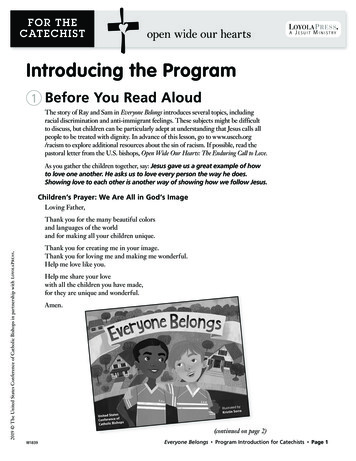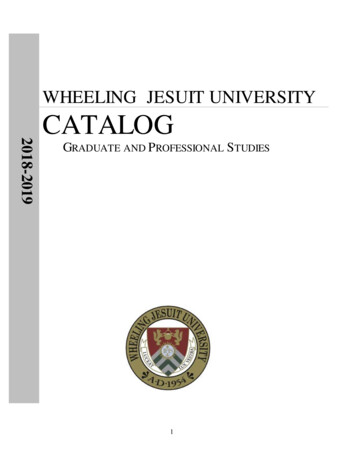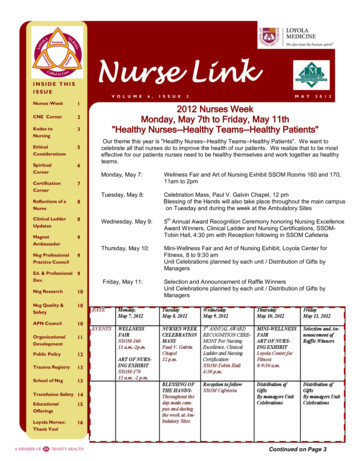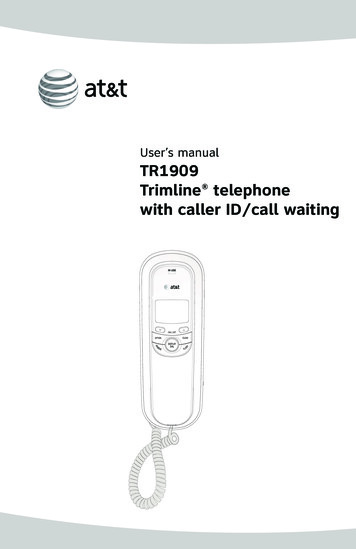
Transcription
FOR THECATECHISTIntroducing the Program1 Before You Read AloudThe story of Ray and Sam in Everyone Belongs introduces several topics, includingracial discrimination and anti-immigrant feelings. These subjects might be difficultto discuss, but children can be particularly adept at understanding that Jesus calls allpeople to be treated with dignity. In advance of this lesson, go to www.usccb.org/racism to explore additional resources about the sin of racism. If possible, read thepastoral letter from the U.S. bishops, Open Wide Our Hearts: The Enduring Call to Love.As you gather the children together, say: Jesus gave us a great example of howto love one another. He asks us to love every person the way he does.Showing love to each other is another way of showing how we follow Jesus.Children’s Prayer: We Are All in God’s ImageLoving Father,Thank you for the many beautiful colorsand languages of the worldand for making all your children unique.Thank you for creating me in your image.Thank you for loving me and making me wonderful.Help me love like you.2019 The United States Conference of Catholic Bishops in partnership withHelp me share your lovewith all the children you have made,for they are unique and wonderful.Amen.(continued on page 2)W1839Everyone Belongs Program Introduction for Catechists Page 1
FOR THECATECHIST2 ConnectTalk with the children about how Jesus loved everyone. Ask them about thepeople they love. How do they feel when they spend time with people they love?Explain to the children that Jesus wants us to treat everyone the way we treat thepeople we love. Talk with the children about how to show Jesus that we love himby showing love to everyone around us. Give them examples of how we respectour friends, family, and others and how we celebrate what makes each of usunique, as well as what makes us the same.3 StoriesThe story of Ray and Sam and their community shows us how to celebrate giftsfrom other cultures and welcome people into our communities. Explain to thechildren that they have much in common with Ray and Sam.The boys in the story recognize when something wrong happens, and they takethe initiative to change it. Sam finds a way to be brave, confront his brother(someone he cares a lot about), and stand up for his best friend. Sam chooses lovefor his brother, for Ray, and for his community by doing what he knows is right.2019 The United States Conference of Catholic Bishops in partnership withAs you read the story, pause and ask yourself these questions: How do you know that Sam and Ray are best friends? How does the message on the garage door make Ray feel? Why doeshe feel this way? What does Sam learn about Ray’s family? How do Sam and hisclassmates help their neighborhood feel more welcoming? How does Carter say he’s sorry? Why is it important to say, “I’m sorry”? How do Ray and Sam let each other know they are loved?4 Moving OnOnce the class has read the story, work with the children to complete theworksheet. Talk with them about how they can be examples of God’s love bybeing a good friend to other children. Explain that they can help others feelGod’s love by appreciating what makes each child unique and discoveringshared characteristics.W1839Everyone Belongs Program Introduction for Catechists Page 2
FOR THECATECHISTKindergarten:We Are Loved by GodMATERIALS› 5 large sheets ofpaper, each withone letter of theword LOVED› Masking Tape1 Begin› Crayons or markers› Various craftsuppliesSay: We believe that Jesus is with us allthe time. Even when you feel alone, Jesusis with you. He is your best friend in theworld. Jesus is with us all the time in ourhearts. [Ask the children to point to theirhearts.] If we listen, Jesus helps us knowhow to love other people.Talk with the children about how we believeGod is present in every person. Say: Each ofus is loved by God, with all that makes usthe same and all that makes us different.We may enjoy playing the same gamesor spending time with our friends andfamilies, and we may have differenthobbies or talents, or come from differentcultures or ethnic backgrounds. Thesedifferences are gifts.Say: Sometimes people do not love otherslike they should. People are treated unfairlybecause they are new to a place, or theirskin is a different color than someone else’s,or they look different, or they speak withan accent.(continued on page 2)KindergartenNameSay: We are going to read a story of twofriends who are the same in many ways,but also different in other ways. Thedifferences between the boys are goodand give the neighborhood a great gift.God loves each of us. God wants us to love one another like Jesusloved others—especially his closest friends, the disciples. We showour love for God by loving all the different things about each oneof us, as well as those things that we share in common.Sam and Ray were good friends. They had things incommon and things about them that were different.Think about what makes you special. Below, draw apicture of yourself that shows your special qualities.Read aloud the story Everyone Belongs. Thendistribute the worksheet. Read aloud theintroduction. Discuss how it is important to loveeveryone. Give examples of how we listen toJesus by loving our friends, family, and others.2 ConnectHelp the children connect to the story andinvite them to share how they can be lovingtoward other children. Guide them to developa sense that they are each loved by God, and sois everyone around them, which is why we treatothers with respect and dignity.W1840DateWe Are Loved by God2019 The United States Conference of Catholic Bishops in partnership with2019 The United States Conference of Catholic Bishops in partnership withSay: When people are not treated well, it issad and wrong. Jesus wants us to love allpeople.Write two things that make you special on the lines below.I can jump high.I can sing.Grade KW1840Grade K Everyone Belongs Everyone BelongsCatechist’s Page Children’s Page Page 1
FOR THECATECHISTNext, tape to the wall the sheets of paper withthe letters that spell L-O-V-E-D.Read aloud the first set of activity directionson the worksheet. Then allow time for thechildren to draw a picture of themselves. Whenthe children are finished, have them decoratetheir pictures with craft supplies.Read aloud the second set of activity directions.Allow time for the children to write what isspecial about themselves. When they havefinished, invite volunteers to share theirwork with the class. After the children aredone sharing, talk about all the things thatmake each of them special and unique. Say:God loves each of us because of ouruniqueness.Ask each child to tape their work to the wallunder the word LOVED.3 Close2019 The United States Conference of Catholic Bishops in partnership withShow the children the “God’s Children of theWorld” slideshow. (This slideshow, courtesyof Catholic Relief Services, contains imagesof children from many countries around theworld.)W1840 Ask: What do you see the childrendoing that you also do? (playing, ridinga bike, going to school, eating, dancing)If you don’t have the ability to show theslideshow, you might print and show photosof children doing these or other activities. Explain that there are things that makeall children the same—including God’spresence in every child. Say: There arealso differences among children ofthe world: for example, how theydress, speak, or do things. They maycome from different cultures or havedifferent traditions. These differencesare gifts and make us special. Explain that sometimes people don’tshow love to one another like they should.Sometimes people use differences tomistreat others. This is wrong and a sin.We know that God loves each of us, nomatter what. Say: Because we follow Jesus, we needto treat one another in ways that showwe know how special and loved eachperson is, especially when it seemsthat someone might be different fromus. We should celebrate the ways Godmakes each of us different. God lovesthe differences we bring from ourcultures and traditions.Pray together the prayer We Are All in God’sImage, found on page 1 of Introducing theProgram.Suggested Additional Activities: Say: Think about what makes yourfriends and classmates the same andwhat makes them different and special. Say: Play with or talk to other childrenwho seem different from you. Discoverhow you are alike and the unique andspecial ways you are different. Ask: What is something you can do toshow someone how special he or sheis? Let this person know he or she isloved by God.Grade K Everyone Belongs Catechist’s Page Page 2
KindergartenNameDateWe Are Loved by GodGod loves each of us. God wants us to love one another like Jesusloved others—especially his closest friends, the disciples. We showour love for God by loving all the different things about each oneof us, as well as those things that we share in common.2019 The United States Conference of Catholic Bishops in partnership withSam and Ray were good friends. They had things incommon and things about them that were different.Think about what makes you special. Below, draw apicture of yourself that shows your special qualities.Write two things that make you special on the lines below.W1840Grade K Everyone Belongs Children’s Page
FOR THECATECHISTGrade 1:What Makes a Person?MATERIALS› Whiteboard,chalkboard or largesheets of paper andmasking tape› Coloring supplies1 Begin› PaperDiscuss what makes someone a person. On theboard or a large sheet of paper taped to the wall,ask the children to make a list of their favoritepeople. The list can be of people they knowpersonally and/or famous people. After the listis compiled, ask: How do you know each ofthese people is a person? (Possible responses:Everyone has a body, a name, a family, and soon.) Say: We believe each person is madeby God. God’s image is present in everyone of the people on this list and in everyone of you. God loves every person in theworld. It is because of that love that wetreat everyone with respect and dignity.When the children have finished, ask them toshare their work with the class.Say: Our families come from differentplaces. Each family might celebrateimportant times of the year differently,and we each have different hobbies orinterests, abilities, and gifts. God lovesthe unique things about our families. Butsometimes, those differences have beenused to treat others differently or unfairly,like in the story Everyone Belongs. Somepeople do not recognize the dignity of(continued on page 2)Read aloud the story Everyone Belongs.Grade 12019 The United States Conference of Catholic Bishops in partnership with2 ConnectNameWhat Makes a Person?Talk about how in the story Ray’s family wasn’ttreated with respect. Ask: What did Carter doto make the Ikangas feel unwelcome? Howdid Ray’s family feel after the messagewas written on their garage door? Howdid Sam and his classmates help themfeel better? Allow time for the children torespond. (Accept reasonable responses.)Read aloud the first set of activity directionsand have the children complete the activity.W1841God loves each of us. As followers of Jesus, we show our love for Godby how we treat our families, friends, and others. We believe that Godis present in each one of us.We know God is present in our families. What is one specialthing about your family? Write it on the line below.My grandma lives with us.We know God created all the unique things about us, so we treat one another with love anddignity.Work with two to three classmates to list five ways you can show someone respect.1. Smile.2019 The United States Conference of Catholic Bishops in partnership withDistribute the worksheet and read aloud thefirst paragraph. Say: God’s children comefrom many cultures and traditions. Themany cultures of the world are differentand wonderful. We learn about ourselvesand our traditions from our families andcommunities. We have many culturesrepresented in our community.Date2. Be kind.3. Don’t use put-downs.4. Help others.5. Don’t yell.Grade 1W1841Grade 1 Everyone Belongs Everyone BelongsCatechist’s Page Children’s Page Page 1
FOR THECATECHIST2019 The United States Conference of Catholic Bishops in partnership withothers whose culture or color of skin isdifferent from their own. When someonedoesn’t recognize our dignity, it is wrong.It is a sin to treat others unfairly becauseof their skin color, or because their familycelebrates events or holidays differently,or comes from a different place in thecountry or the world. We should showGod’s love to others no matter how muchwe have in common or how much isdifferent about us.W18413 CloseRead aloud the second paragraph and the secondset of activity directions. Invite the children towork together to complete the activity. Ask thechildren to report their lists to the entire classand write them on the board or large sheet ofpaper on the wall. Then invite the class to choosetheir five favorite ways to show respect from allthe lists. Post this “top five” list in the classroom.Say: We know that God loves all of usand God loves all the things that make usthe same. He also loves the many gifts,cultures, and traditions that make usdifferent. We should celebrate both ourdifferences and similarities. Pray togetherthe prayer We Are All in God’s Image, foundon page 1 of Introducing the Program.Grade 1 Everyone Belongs Catechist’s Page Page 2
Grade 1NameDateWhat Makes a Person?God loves each of us. As followers of Jesus, we show our love for Godby how we treat our families, friends, and others. We believe that Godis present in each one of us.We know God is present in our families. What is one specialthing about your family? Write it on the line below.We know God created all the unique things about us, so we treat one another with love anddignity.Work with two to three classmates to list five ways you can show someone respect.2019 The United States Conference of Catholic Bishops in partnership with1.2.3.4.5.W1841Grade 1 Everyone Belongs Children’s Page
FOR THECATECHISTGrade 2:How Do We Treat EachOther?2 ConnectAfter reading the story, distribute the worksheetand read aloud the introduction. Ask: Who inthe story was acting like a friend? (Possibleresponses: Sam, Ray, the classmates, Sr. Bridget,W1842Ask: Who was not being loving in thestory? (Carter) How do you know? (Possibleresponses: he wrote a negative, mean, orbad message on his neighbor’s garage door;he didn’t want the Ikangas to live in theneighborhood; he didn’t like his neighbors(continued on page 2)Grade 2NameDateHow do we treat eachother?Jesus showed us how to love one another in happy times and howto share our sadness too. When we don’t show respect to others itcan hurt them.Think about how you like to be treated by others and how you should treat othersin return. Write three ways you can show others love and respect on the linesbelow.1. Don’t tattle.2. Be kind.2019 The United States Conference of Catholic Bishops in partnership with2019 The United States Conference of Catholic Bishops in partnership withDiscuss with the children the qualities andcharacteristics of a good friend. Talk about howimportant it is to be a good friend to others.Say: We treat our friends with respect andlove. We share important things aboutourselves with our friends. We share funtimes, and we also share our feelings whenwe are sad. Jesus is the best friend wecould ever have in the world. Jesus wantsto know when we are happy, and to sharethat happiness with him. He especiallywants us to know he loves us when weare sad. Talk about how we show Jesus we arefriends with him by loving our friends. Jesusshows us how to be blessed and holy.Read together or aloud the story Everyone Belongs.› Crayons or markersFr. Mateo, Sam’s family and the Ikanga family)Read aloud the directions for the first activityand invite the children to complete the activity.When they are finished, ask volunteers to sharetheir work.1 BeginSay: Jesus knows how important it is to havefriends. We call Jesus’ closest friends hisdisciples. We are also called to be disciplesand show Jesus that we love him by lovingothers. Sometimes loving others is difficultand we don’t show love for others like weshould. When we deliberately disrespector treat another person poorly, we are notshowing our love for God. That is a sin. Let’sread a story about two friends who are alot like you and your friends.MATERIALS3. Cheer up someone who is sad.Below, write three ways you can show you are sorry when you don’t love otherslike Jesus.1. Say “I’m sorry.”2. Ask how I can make things better.3. Invite him or her to play.(Continued on Page 2)Grade 2W1842Grade 2 Everyone Belongs Everyone Belongs Children’s PageCatechist’s Page Page 1Page 1
FOR THECATECHISTbecause they were new; he didn’t like that theIkangas looked different from his family.) Ask:How would you feel if someone wrotesomething mean on your door? Say:Carter’s actions were not ok. In fact, hisactions were sinful. His actions also reallyhurt Ray’s family’s feelings. What are wayswe can show we are sorry when we realizewe are wrong? (Accept reasonable responses.)2019 The United States Conference of Catholic Bishops in partnership withRead aloud the second set of activity directionsand have the children complete the activity.When they are finished, invite volunteers toshare their work.W18423 CloseSay: Jesus’ disciples celebrate wheneveryone is together. Jesus treats all ofus with love, and we should follow Jesus’example. Read aloud the activity directions onpage 2 of the worksheet and ask the children tocomplete the activity. Invite volunteers to sharetheir drawings. (Answers will vary.)Finally, pray together the prayer We Are All inGod’s Image, found on page 1 of Introducingthe Program.Grade 2 Everyone Belongs Catechist’s Page Page 2
Grade 2NameDateHow Do We Treat EachOther?Jesus showed us how to love one another in happy times and howto share our sadness. When we don’t show respect to others, itcan hurt them.Think about how you like to be treated by others and how you should treat othersin return. On the lines below, write three ways you can show others love andrespect.1.2019 The United States Conference of Catholic Bishops in partnership with2.3.Below, write three ways you can show you are sorry when you don’t love otherslike Jesus did.1.2.3.(continued on page 2)W1842Grade 2 Everyone Belongs Children’s Page Page 1
Grade 2NameDate2019 The United States Conference of Catholic Bishops in partnership withOur community is better when we all follow Jesus’ example and love our families,friends, and others. Draw a picture of your community celebrating the gifts we allbring.W1842Grade 2 Everyone Belongs Children’s Page Page 2
FOR THECATECHISTGrade 3:Who Is Our Neighbor?1 BeginRead together the story Everyone Belongs.2 ConnectDistribute the worksheet. Ask: Did you noticein the story that Carter apologized to theIkanga family and to the neighborhood?What do you think Carter said to Dr.Ikanga to let him know he was sorryfor what he did? (Responses will vary.)(continued on page 2)Grade 3NameDateWho are our neighbors?Who Is Our Neighbor?Why should we love our neighbors?Jesus gave us a commandment: to love our neighbors. Jesus loves useven when we sin, and he always forgives us when we are truly sorryfor our sins. Together, we can follow Jesus and be like Sam and Ray—celebrating our neighbors no matter where they come from.Allow time for the children to respond to eachquestion. (Accept reasonable responses.) Thensay: Every person is a child of God and thatmakes us part of a human family as well.Jesus gave us a commandment to loveone another. But sometimes we don’t liveup to that commandment. We hurt oneanother with words and actions. When wehurt others, we also hurt Jesus. Jesus gaveus a sacrament for making our relationshipwith him whole again. When we sin ordon’t respect other people, our entirecommunity suffers. By confessing oursins in the Sacrament of Reconciliation,we receive the grace to make our humanfamily whole again.We are all children of God. Our relationships with our familiesand communities are one way we show our love for God, whohas given us families and friends to love. Think about what Jesus meant when he told usto love our neighbors. Then write three examples of your neighbors on the lines below.Lifeguard at the swimming pool, server at a restaurant, people atchurch, even if I don’t know them.In Everyone Belongs, Carter apologized to the Ikangas and the community. He alsowent to confession and talked with Fr. Mateo. What do you think Carter could havesaid to show he was sorry for his sins?2019 The United States Conference of Catholic Bishops in partnership with2019 The United States Conference of Catholic Bishops in partnership withAsk: What did Jesus mean when he said tolove your neighbor as yourself?W1843› Crayons or markersBeing in good relationship with ourfamilies and communities is one way weshow our love for God.Read aloud or ask a child to read aloud thestory of the greatest commandment:Matthew 22:34–40.“When the Pharisees heard that he hadsilenced the Sadducees, they gathered togetherand one of them [a scholar of the law] testedhim by asking, ‘Teacher, which commandmentin the law is the greatest?’ He said to him,‘You shall love the Lord, your God, with allyour heart, with all your soul, and with allyour mind. This is the greatest and the firstcommandment. The second is like it: You shalllove your neighbor as yourself. The wholelaw and the prophets depend on these twocommandments.’”MATERIALSI’m sorry I caused you pain. What I did was disrespectful andwrong. I won’t ever do it again.Think about a time you apologized or celebrated the Sacrament of Reconciliation.How did you feel afterward? Draw a picture that shows how you felt.Grade 3W1843Grade 3 Everyone Belongs Everyone BelongsCatechist’s Page Children’s Page Page 1
FOR THECATECHISTRead aloud the directions for the first twoactivities on the worksheet and have thechildren complete these activities. Invitevolunteers to share their work.Say: Carter apologized to the Ikangasbecause it was the right thing to do. He alsotalked to Fr. Mateo during the Sacrament ofReconciliation. Fr. Mateo might have askedCarter to apologize as part of his penance.Through God’s forgiveness in Reconciliationand through forgiveness from Dr. Ikanga,Carter received forgiveness from God andfrom his community. The Ikanga family andthe entire community celebrated becausethey were whole again. Ask: Can you thinkof a time when it was important to showsomeone you were sorry? (Allow time for thechildren to reflect.)3 CloseSay: It is important for us to recognizewhen we have done something wrong andhurt others, whether it was intentionalor not. We need to take responsibility forour actions. Part of taking responsibilitycan mean apologizing. It can also meangoing to confession. Participating in theSacrament of Reconciliation can bringhealing to our individual relationships andto our communities.Read aloud the final set of activity directionsand invite the children to do the activity.Finally, pray together the prayer We AreAll in God’s Image, found on page 1 ofIntroducing the Program.2019 The United States Conference of Catholic Bishops in partnership withIf time allows, discuss how Sam also choseto show love to his community. Say: Samdecided he should say something toCarter because he knew what Carter haddone was wrong. What if Sam hadn’t saidsomething to Carter? That would havebeen a sin too! We avoid sin by makingthe choice to do what is right, evenwhen it is difficult and by avoiding doingsomething that we know is wrong.W1843Grade 3 Everyone Belongs Catechist’s Page Page 2
Grade 3NameDateWho Is Our Neighbor?Jesus gave us a commandment: to love our neighbors. Jesus loves useven when we sin, and he always forgives us when we are truly sorryfor our sins. Together, we can follow Jesus and be like Sam and Ray—celebrating our neighbors no matter where they come from.We are all children of God. Our relationships with our familiesand communities are one way we show our love for God, whohas given us families and friends to love. Think about what Jesus meant when he told usto love our neighbors. Then write three examples of your neighbors on the lines below.2019 The United States Conference of Catholic Bishops in partnership withIn Everyone Belongs, Carter apologized to the Ikangas and the community. He alsowent to confession and talked with Fr. Mateo. What do you think Carter could havesaid to show he was sorry for his sins?Think about a time you apologized or celebrated the Sacrament of Reconciliation.How did you feel afterward? Draw a picture that shows how you felt.W1843Grade 3 Everyone Belongs Children’s Page
FOR THECATECHISTGrade 4:Unity in the Body of Christand within the Church. Sin, including actsof racism, can threaten God’s gift of unity.Because of this sin, we fail to recognizethe dignity of some members of ourhuman family, and it breaks the bondsbetween us.Ask: Does anyone remember his or herBaptism? If any of the children were baptizedafter infancy, ask them if they will share whatthey remember about their Baptism. Then ask:Has anyone seen pictures of his or herBaptism? What were some of the detailsin the pictures or stories you have heardfrom your parents or godparents? Whatdo you remember about the Baptism of ayounger sibling or family member at yourchurch? (Possible responses: water, parents,godparents, white gown, a candle) Talk withthe children about how we are baptized intoa new life in Christ, and this means we arebaptized into a community, which is part ofthe Body of Christ. Say: Baptism makesus members of the Body of Christ andbrothers and sisters to one another. Weare baptized into a new family, whomwe care for. Ask: How do we show ourbrothers and sisters in our communitythat we care for them? Write the children’sresponses on the board or on a large sheet ofpaper taped to the wall.Distribute the worksheet and invite volunteersto read aloud the first paragraph and theactivity directions. Ask the children to answerthe questions in small groups. When they arefinished, invite groups to share their responseswith the entire class. You might give a smallprize to the group that correctly answered themost questions.(continued on page 2)Grade 4NameOur Baptism makes us members of the Body of Christ. We are broughtinto a new worldwide family who prays for us and loves us. We alsoshould care for all the members of this family, since each person is achild of God.Think about the story Everyone Belongs. Then write yourresponses to the questions below using the information fromthe story.1. Where in the story did you see peoplehonoring one another’s dignity?Say: As members of the worldwide (andheavenly) Body of Christ, we celebratethe diversity and gifts of the Church’smembers from many cultures. Diversityis not opposed to the Church’s unity.We celebrate the diversity of the manycultures and traditions in communitiesW18442. Where did you see people break thebonds of the Body of Christ?Sam and Ray are good friends. The familiesCarter damaged the Ikangas’ house. Carterincident. Ray shared with Sam how heown home and neighborhood. Carter did notshare things. Sam went to Ray after the2 ConnectArrange the children in small groups and invitethem to read the story Everyone Belongs.DateUnity in the Body of Christdisturbed the Ikangas’ sense of peace in theirwas hurt.recognize the gifts the Ikangas brought to thecommunity. Carter did not recognize the fullhuman dignity of the Ikangas.2019 The United States Conference of Catholic Bishops in partnership with2019 The United States Conference of Catholic Bishops in partnership with1 Begin3. How did the community heal from thisbreak?4. How was each of the character’s choicesmotivated by faith?Carter apologized and received God’sSam learned about the Body of Christ at schoolCarter helped repair the physical damage. TheCarter in the example and imitation of Jesus.forgiveness in the Sacrament of Reconciliation.and shared it with Carter. Dr. Ikanga forgavecommunity made it clear they welcomed theCarter went to confession and apologized to theIkangas by putting up welcoming signs. Sr.Bridget taught her class about the evil of racism,and the community welcomed the Ikangas withIkangas and his community. Carter did his bestto repair the damage.a celebration.Our human dignity makes us all children of God. We are loved because we are all made in God’simage and we are all unique. As followers of Jesus, we celebrate those differences because theyare gifts from God.Grade 4W1844Grade 4 Everyone Belongs Everyone BelongsCatechist’s Page Children’s Page Page 1
FOR THECATECHIST(Questions and sample responses are reproducedbelow.)1.Where in the story did you see peoplehonoring one another’s dignity? (Samand Ray are good friends. The familiesshare things. Sam went to Ray after theincident. Ray shared with Sam how hewas hurt.2.Where did you see people break thebonds of the Body of Christ? (Carterdamaged the Ikangas’ house. Carterdisturbed the Ikangas’ sense of peace intheir own home and neighborhood. Carterdid not recognize the gifts the Ikangasbrought to the community. Carter did notrecognize the full human dignity of theIkangas.)2019 The United States Conference of Catholic Bishops in partnership with3.How did the community heal from thisbreak? (Carter apologized and receivedGod’s forgiveness in the Sacrament ofReconciliation. Carter helped repair thephysical damage. The community madeit clear they welcomed the Ikangas byputting up welcoming signs. Sr. Bridgettaught her class about the evil of racism,and the community welcomed the Ikangaswith a celebration.)4.How was each of the character’schoices motivated by faith? (Samlearned about the Body of Christ atschool and shared it with Carter. Dr.Ikanga forgave Carter in the exampleand imitation of Jesus. Ca
It is because of that love that we treat everyone with respect and dignity. Read aloud the story Everyone Belongs. 2 Connect Talk about how in the story Ray’s family wasn’t treated with respect. Ask: W










